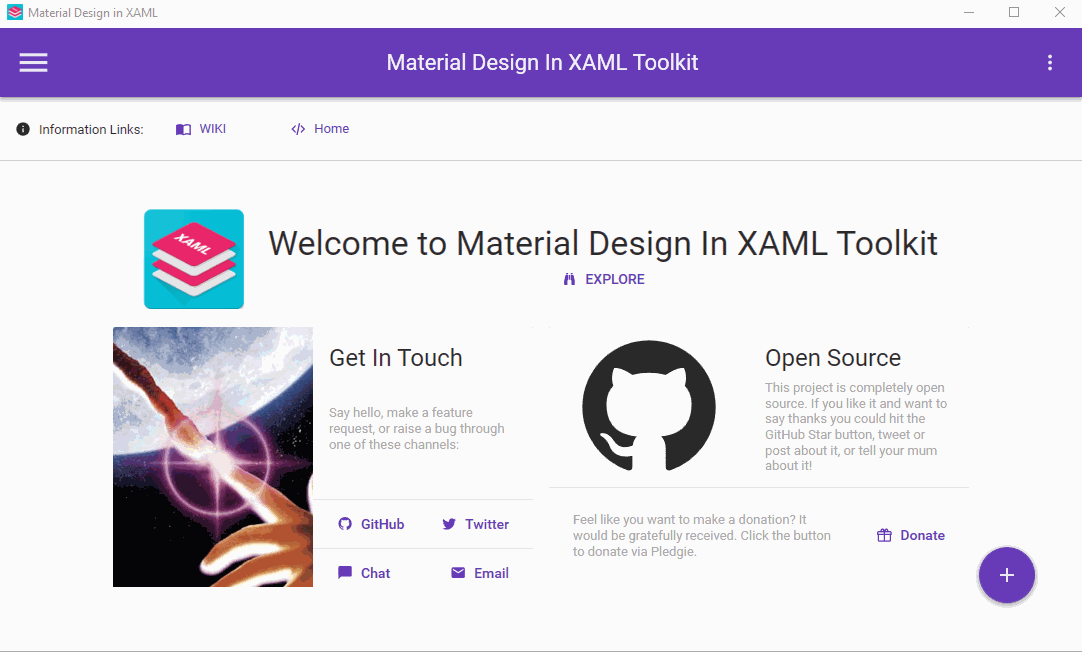原文:How to use Material Desgin with PowerShell
When you create WPF application you have two popular Themes Mahapps and Material Design. You can find they own Github project Mahapps and Material Design.
Today we focus on Material Design and how to use with Powershell.
There is a demonstration project to show all the objects, themes, pages, controls that are available in Material Design.

With the demo project you can view the XAML for each objects.
In your XAML file you can add in specify the namespace. In this example I have Mahapps Windows.
<Controls:MetroWindow
xmlns="http://schemas.microsoft.com/winfx/2006/xaml/presentation"
xmlns:Controls="clr-namespace:MahApps.Metro.Controls;assembly=MahApps.Metro"
xmlns:materialDesign="http://materialdesigninxaml.net/winfx/xaml/themes"
assembly=MaterialDesignThemes.Wpf"
xmlns:iconPacks="http://metro.mahapps.com/winfx/xaml/iconpacks"
xmlns:x="http://schemas.microsoft.com/winfx/2006/xaml"
Title="Apps_MD_Demo"
Height="470" Width="620"
WindowStartupLocation="CenterScreen"
ResizeMode="NoResize"
WindowStyle="None"
BorderThickness="0"
GlowBrush="{DynamicResource AccentColorBrush}"
Background="{DynamicResource MaterialDesignPaper}"
FontFamily="{DynamicResource MaterialDesignFont}"
TextElement.Foreground="{DynamicResource MaterialDesignBody}"
TextElement.FontWeight="Regular"
TextElement.FontSize="13"
TextOptions.TextFormattingMode="Ideal"
TextOptions.TextRenderingMode="Auto"
>
You can add this line xmlns:materialDesign=”http://materialdesigninxaml.net/winfx/xaml/themes” in order to create some Material Design Objects. There is some property for the windows :
But like Mahapps you need to add some in the ResourceDictionary. In this code below I combine in a Mahapps apps with Material Design.
<Window.Resources>
<ResourceDictionary>
<ResourceDictionary.MergedDictionaries>
<!-- Create Metro Style -->
<ResourceDictionary Source="pack://application:,,,/MahApps.Metro;component/Styles/Controls.xaml" />
<ResourceDictionary Source="pack://application:,,,/MahApps.Metro;component/Styles/Fonts.xaml" />
<ResourceDictionary Source="pack://application:,,,/MahApps.Metro;component/Styles/Colors.xaml" />
<ResourceDictionary Source="pack://application:,,,/MahApps.Metro;component/Styles/Accents/Cobalt.xaml"/>
<ResourceDictionary Source="pack://application:,,,/MahApps.Metro;component/Styles/Accents/BaseLight.xaml" />
<!-- MaterialDesign Style -->
<ResourceDictionary Source="pack://application:,,,/MaterialDesignThemes.Wpf;component/Themes/MaterialDesignTheme.Light.xaml" />
<ResourceDictionary Source="pack://application:,,,/MaterialDesignThemes.Wpf;component/Themes/MaterialDesignTheme.Defaults.xaml" />
<ResourceDictionary Source="pack://application:,,,/MaterialDesignColors;component/Themes/Recommended/Primary/MaterialDesignColor.Blue.xaml" />
</ResourceDictionary.MergedDictionaries>
</ResourceDictionary>
</Window.Resources>
In some case if you want to overide themes for object you can add some ResourceDictionary.MergedDictionaries. Here some example for the object : Buttons,Card,Popup,TextBox,Flipper.
<ResourceDictionary Source="pack://application:,,,/MaterialDesignThemes.Wpf;component/Themes/MaterialDesignTheme.Button.xaml" />
<ResourceDictionary Source="pack://application:,,,/MaterialDesignThemes.Wpf;component/Themes/MaterialDesignTheme.Card.xaml" />
<ResourceDictionary Source="pack://application:,,,/MaterialDesignThemes.Wpf;component/Themes/MaterialDesignTheme.PopupBox.xaml"/>
<ResourceDictionary Source="pack://application:,,,/MaterialDesignThemes.Wpf;component/Themes/MaterialDesignTheme.TextBox.xaml" />
<ResourceDictionary Source="pack://application:,,,/MaterialDesignThemes.Wpf;component/Themes/MaterialDesignTheme.Flipper.xaml" />
In Your Powershell script you need to add assembly.
[System.Reflection.Assembly]::LoadWithPartialName(‘presentationframework‘) | out-null
[System.Reflection.Assembly]::LoadFrom(‘assembly\MahApps.Metro.dll‘) | out-null
[System.Reflection.Assembly]::LoadFrom(‘assembly\System.Windows.Interactivity.dll‘) | out-null
[System.Reflection.Assembly]::LoadFrom(‘assembly\MaterialDesignThemes.Wpf.dll‘) | out-null
[System.Reflection.Assembly]::LoadFrom(‘assembly\MaterialDesignColors.dll‘) | out-nullThe ColorZone is an object like card and you can use different Mode :
<materialDesign:ColorZone Mode="PrimaryDark" CornerRadius="12" materialDesign:ShadowAssist.ShadowDepth="Depth5" Margin="10" Width="300" Height="200">
</materialDesign:ColorZone>
You can nested them :
<materialDesign:ColorZone Mode="PrimaryDark" CornerRadius="12" materialDesign:ShadowAssist.ShadowDepth="Depth5" Margin="10" Width="300" Height="200">
<materialDesign:ColorZone Mode="Light" CornerRadius="12" materialDesign:ShadowAssist.ShadowDepth="Depth5" Margin="10" Width="180" Height="180">
</materialDesign:ColorZone>
</materialDesign:ColorZone>
Like Mahapps Material Design include some Icons Here a example Twitter icon.
<StackPanel Orientation="Horizontal">
<materialDesign:ColorZone Mode="PrimaryDark" CornerRadius="12" materialDesign:ShadowAssist.ShadowDepth="Depth5" Margin="10" Width="300" Height="200">
<StackPanel Orientation="Horizontal" Margin="55 0 0 0">
<materialDesign:ColorZone Mode="Light" CornerRadius="12" materialDesign:ShadowAssist.ShadowDepth="Depth5" Margin="10" Width="180" Height="180">
<materialDesign:PackIcon Kind="Twitterbox" Height="64" Width="64"/>
</materialDesign:ColorZone>
</StackPanel>
</materialDesign:ColorZone>
<StackPanel Orientation="Horizontal">
<materialDesign:ColorZone Mode="PrimaryDark" CornerRadius="12" materialDesign:ShadowAssist.ShadowDepth="Depth5" Margin="10" Width="300" Height="200">
<StackPanel Orientation="Horizontal">
<materialDesign:PackIcon Kind="Twitterbox" Height="64" Width="64"/>
<materialDesign:ColorZone Mode="Light" CornerRadius="12" materialDesign:ShadowAssist.ShadowDepth="Depth5" Margin="10" Width="180" Height="180">
</materialDesign:ColorZone>
</StackPanel>
</materialDesign:ColorZone>
</StackPanel>
Written by Jérôme Bezet-Torres @JM2K69.
How to use Material Desgin with PowerShell
原文:https://www.cnblogs.com/lonelyxmas/p/12178977.html